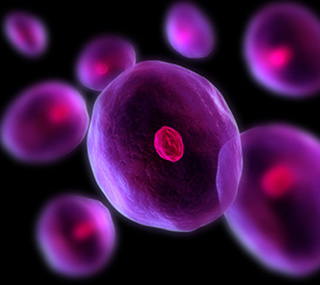Uterine (endometrial) cancer
Endometrial cancer is a disease in which malignant (cancer) cells form in the tissues of the endometrium.
The endometrium is the lining of the uterus, a hollow, muscular organ in a woman’s pelvis. The uterus is where a fetus grows. In most nonpregnant women, the uterus is about 3 inches long. The lower, narrow end of the uterus is the cervix, which leads to the vagina.
Cancer of the endometrium is different from cancer of the muscle of the uterus, which is called sarcoma of the uterus. Most endometrial cancers are adenocarcinomas (cancers that begin in cells that make and release mucus and other fluids).
The close collaboration among our doctors and our research scientists means that new drugs and treatments developed in the laboratory can quickly move to the clinic, offering our patients immediate access to the latest therapies.

Because endometrial cancer begins inside the uterus, it does not usually show up in the results of a Pap test. For this reason, a sample of endometrial tissue must be removed and examined under a microscope to look for cancer cells. One of the following procedures may be used:
Endometrial biopsy: The removal of tissue from the endometrium (inner lining of the uterus) by inserting a thin, flexible tube through the cervix and into the uterus. The tube is used to gently scrape a small amount of tissue from the endometrium and then remove the tissue samples. A pathologist views the tissue under a microscope to look for cancer cells.
Dilatation and curettage: Surgery to remove samples of tissue or the inner lining of the uterus. The cervix is dilated and a curette (spoon-shaped instrument) is inserted into the uterus to remove tissue. Tissue samples may be taken and checked under a microscope for signs of disease. This procedure is also called a D&C.
Sources: National Cancer Institute and UC Davis Comprehensive Cancer Center
- Bleeding or discharge not related to menstruation (periods)
- Difficult or painful urination
- Pain during sexual intercourse
- Pain in the pelvic area
Sources: National Cancer Institute and UC Davis Comprehensive Cancer Center
- Estrogen-only hormone replacement therapy: Estrogen may be given to replace the estrogen no longer produced by the ovaries in postmenopausal women or women whose ovaries have been removed. This is called hormone replacement therapy (HRT), or hormone therapy (HT). The use of hormone replacement therapy that contains only estrogen increases the risk of endometrial cancer. For this reason, estrogen therapy alone is usually prescribed only for women who do not have a uterus.
When estrogen is combined with progestin (another hormone), it is called combination estrogen-progestin replacement therapy. For postmenopausal women, taking estrogen in combination with progestin does not increase the risk of endometrial cancer. - Early menstruation: Beginning to have menstrual periods at an early age increases the number of years the body is exposed to estrogen and increases a woman's risk of endometrial cancer.
- Late menopause: Women who reach menopause at an older age are exposed to estrogen for a longer time and have an increased risk of endometrial cancer.
- Never being pregnant: Because estrogen levels are lower during pregnancy, women who have never been pregnant are exposed to estrogen for a longer time than women who have been pregnant. This increases the risk of endometrial cancer.
- Poor diet, smoking, lack of exercise.
Sources: National Cancer Institute and UC Davis Comprehensive Cancer Center
Surgery
Surgery (removing the cancer in an operation) is the most common treatment for endometrial cancer. The following surgical procedures may be used:
- Total hysterectomy: Surgery to remove the uterus, including the cervix. If the uterus and cervix are taken out through the vagina, the operation is called a vaginal hysterectomy. If the uterus and cervix are taken out through a large incision (cut) in the abdomen, the operation is called a total abdominal hysterectomy. If the uterus and cervix are taken out through a small incision (cut) in the abdomen using a laparoscope, the operation is called a total laparoscopic hysterectomy.
- Bilateral salpingo-oophorectomy: Surgery to remove both ovaries and both fallopian tubes.
- Radical hysterectomy: Surgery to remove the uterus, cervix, and part of the vagina. The ovaries, fallopian tubes, or nearby lymph nodes may also be removed.
Even if the doctor removes all the cancer that can be seen at the time of the surgery, some patients may be given radiation therapy or hormone treatment after surgery to kill any cancer cells that are left. Treatment given after the surgery, to lower the risk that the cancer will come back, is called adjuvant therapy.
Radiation therapy
Radiation therapy is a cancer treatment that uses high-energy x-rays or other types of radiation to kill cancer cells or keep them from growing. There are two types of radiation therapy. External radiation therapy uses a machine outside the body to send radiation toward the cancer. Internal radiation therapy uses a radioactive substance sealed in needles, seeds, wires, or catheters that are placed directly into or near the cancer. The way the radiation therapy is given depends on the type and stage of the cancer being treated.
Hormone therapy
Hormone therapy is a cancer treatment that removes hormones or blocks their action and stops cancer cells from growing. Hormones are substances made by glands in the body and circulated in the bloodstream. Some hormones can cause certain cancers to grow. If tests show that the cancer cells have places where hormones can attach (receptors), drugs, surgery, or radiation therapy are used to reduce the production of hormones or block them from working.
Chemotherapy
Chemotherapy is a cancer treatment that uses drugs to stop the growth of cancer cells, either by killing the cells or by stopping the cells from dividing. When chemotherapy is taken by mouth or injected into a vein or muscle, the drugs enter the bloodstream and can reach cancer cells throughout the body (systemic chemotherapy). When chemotherapy is placed directly into the spinal column, an organ, or a body cavity such as the abdomen, the drugs mainly affect cancer cells in those areas (regional chemotherapy). The way the chemotherapy is given depends on the type and stage of the cancer being treated.
Clinical Trials
UC Davis Comprehensive Cancer Center has a large clinical trials network, allowing our patients access to the newest drugs and therapies before they become widely available. During all stages of your treatment you should talk to your medical specialist about what clinical trials may be available for you.
Sources: National Cancer Institute and UC Davis Comprehensive Cancer Center
Gynecologic Oncology (Surgery)
 Rebecca Ann Brooks, M.D.
Rebecca Ann Brooks, M.D.
Associate Professor, Gynecologic Oncology
 Hui (Amy) Chen, M.D.
Hui (Amy) Chen, M.D.
Assistant Clinical Professor, Gynecologic Oncology
 Gary Leiserowitz, M.D., M.S.
Gary Leiserowitz, M.D., M.S.
Professor and Chief, Gynecologic Oncology
Fellowship Director, Gynecologic Oncology
 Rachel Ruskin, M.D.
Rachel Ruskin, M.D.
Assistant Professor, Gynecologic Oncology
Radiation Oncology
 Richard Valicenti, M.D., M.A., FASTRO
Richard Valicenti, M.D., M.A., FASTRO
Professor
Department Chair of Radiation Oncology
Dietitians
 Danielle Baham, M.S., R.D.
Danielle Baham, M.S., R.D.
 Kathleen Newman, R.D., C.S.O.
Kathleen Newman, R.D., C.S.O.
Genetic Counselors
Social Workers
 Sara Chavez, L.C.S.W., O.S.W.-C., A.C.H.P.-S.W.
Sara Chavez, L.C.S.W., O.S.W.-C., A.C.H.P.-S.W.
 Jenifer Cooreman, L.C.S.W., O.S.W.-C.
Jenifer Cooreman, L.C.S.W., O.S.W.-C.
Stage I
In stage I, cancer is found in the uterus only. Stage I is divided into stages IA, IB, and IC, based on how far the cancer has spread.
- Stage IA: Cancer is in the endometrium only.
- Stage IB: Cancer has spread into the inner half of the myometrium (muscle layer of the uterus).
- Stage IC: Cancer has spread into the outer half of the myometrium.
Stage II
In stage II, cancer has spread from the uterus to the cervix, but has not spread outside the uterus. Stage II is divided into stages IIA and IIB, based on how far the cancer has spread into the cervix.
- Stage IIA: Cancer has spread to the glands where the cervix and uterus meet.
- Stage IIB: Cancer has spread into the connective tissue of the cervix.
Stage III
In stage III, cancer has spread beyond the uterus and cervix, but has not spread beyond the pelvis. Stage III is divided into stages IIIA, IIIB, and IIIC, based on how far the cancer has spread within the pelvis.
- Stage IIIA: Cancer has spread to one or more of the following:
- the outermost layer of the uterus; or
- tissue just beyond the uterus; or
- the peritoneum.
- Stage IIIB: Cancer has spread beyond the uterus and cervix, into the vagina.
- Stage IIIC: Cancer has spread to lymph nodes near the uterus.
Stage IV
In stage IV, cancer has spread beyond the pelvis. Stage IV is divided into stages IVA and IVB, based on how far the cancer has spread.
- Stage IVA: Cancer has spread to the bladder and/or bowel wall.
- Stage IVB: Cancer has spread to other parts of the body beyond the pelvis, including lymph nodes in the abdomen and/or groin.
Sources: National Cancer Institute and UC Davis Comprehensive Cancer Center






 Nicole Mans, M.S., L.C.G.C.
Nicole Mans, M.S., L.C.G.C. Jeanna Welborn, M.D.
Jeanna Welborn, M.D.